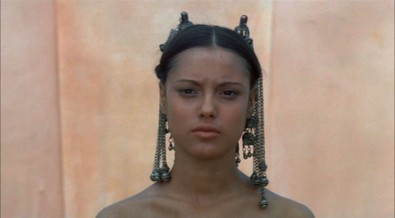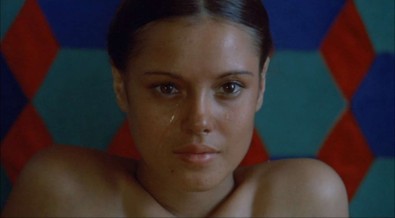I recently watched the excellent BFI reissue of Pier Paolo Pasolini’s Arabian Nights (aka Il fiore delle mille e una notte) and found it to be a typically Italian mix of the breathtaking and the laughable. Almost unbearably gorgeous visuals and music (by Ennio Morricone) were balanced against rather variable acting, the usual dubbing issues and occasional jarring lapses in logic and continuity (which, to be fair, may not have been entirely Pasolini’s fault, as the film was heavily cut before release by its producer Alberto Grimaldi). The film is picaresque, episodic and light-hearted (at least on the surface) in a similar manner to the other films that make up the director’s “Trilogy of Life”. Throughout the film, multiple stories unfold within stories, and in my opinion the most memorable and involving of these is the tale of Aziz and Aziza.
This story tells of two cousins, whose prospective marriage falls apart when Aziz falls in love with a mysterious woman on his wedding day. She communicates with him via cryptic messages that are perversely translated and furnished with responses by the broken-hearted Aziza. Although there is a certain charm to the amateurish enthusiasm of much of the film’s cast, the acting in this section is of a noticeably higher standard, with the straight-faced and tragic acceptance conveyed by Tessa Bouché as Aziza providing a nice counterpoint to the suitably buffoonish and foolhardy performance by Pasolini favourite Ninetto Davoli as Aziz. However, most memorable of all for me was the actress playing the “other woman” (later revealed to be the serial seductress Budur the Mad One), whose identity I have been completely unable to discover.




I was struck not only by the beauty of this actress, but also by her haunting performance. Whoever she was, it seems likely that she appeared in few, if any other films, as Pasolini tended to favour amateur performers in his later films over the jobbing professional actors preferred by his contemporaries. However, I would certainly be grateful to hear from anyone out there with any clue as to her identity. In the meantime, if you want to read more about this flawed but unforgettable film, there is a very interesting article about the cross-currents between Pasolini’s life and work here.
I think her name is Abadit Ghidei.
Kind regards
Thomas Rasmussen
Hi Thomas,
I’m a bit confused, as some online information about the film seems to list that actress as playing Princess Dunya, not Budur…?
Watch the movie again. I don’t want to give any spoilers for those who haven’t seen it, but after watching it just now, I’m pretty sure Thomas is correct.
I’m sorry, there’s a mistake : Abadit Ghidei is Budur, not Dunya.
Dunya is played by Luigina Rocchi !
Christopher, I have the same curiousity. It’s perplexing to me that the actress in the iconic photo representing this film is not billed more highly so that we’re wondering who she is. I don’t see Budur credited.
Most likely she is Luigina Rocchi.
She is credited as Claudia Rocchi in “Dolce calda Lisa” (Sweet Hot Lisa, IMDB tt0080642), the only movie featuring her in the main role.
In other movies that credit “Luigina Rocchi” you can see that she is one and the same with Claudia Rocchi.
Hi Marco.. please can you give me information about Claudia Rocchi starred in Dolce Calda Lisa (1980), In an Italian movie..
Well, just search for tt0080642 on Google. I know no more of what you can find on the web. I have got a copy of the movie “Dolce Calda Lisa”, but you can find many screeshots of the movie using Google Images or Bing Images.
Another source of information:
https://www.themoviedb.org/movie/384527-dolce-calda-lisa
Hi Marco.. Can you please me information about Claudia Rocchi who starred in Dolce Calda Lisa (1980) in an Italian movie..
Definetly Luigina Rocchi